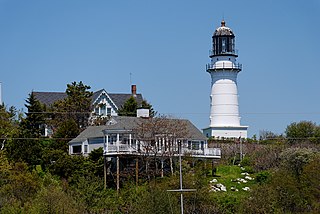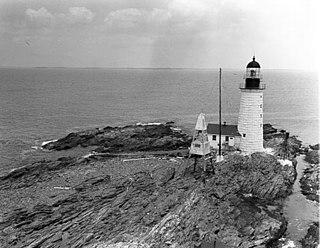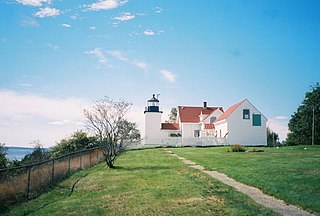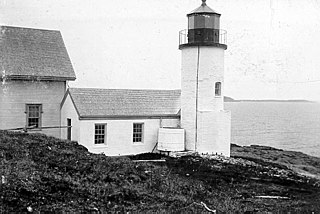Related Research Articles

Portland Head Light is a historic lighthouse in Cape Elizabeth, Maine. The light station sits on a head of land at the entrance of the primary shipping channel into Portland Harbor, which is within Casco Bay in the Gulf of Maine. Completed in 1791, it is the oldest lighthouse in Maine. The light station is automated, and the tower, beacon, and foghorn are maintained by the United States Coast Guard, while the former lighthouse keepers' house is a maritime museum within Fort Williams Park.

Cape Elizabeth Light is a lighthouse in Cape Elizabeth, at the southwestern entrance to Casco Bay in Maine.

Wood Island Light is an active lighthouse on the eastern edge of Wood Island in Saco Bay, on the southern coast of Maine. The light is just outside the entrance to Biddeford Pool and the end of the Saco River. The lighthouse is a 47-foot (14 m) conical white tower of granite rubble. The light itself sits 71 feet (22 m) above mean high water. Its automated beacon alternates between green and white every 10 seconds.

Halfway Rock Lighthouse is a lighthouse located on a barren ledge in Casco Bay, Maine. The lighthouse tower, which has a height of 76 feet (23 m), and the attached ex-boathouse are all that remains, as the other buildings have been taken away in storms. The name "Halfway Rock" comes from the position of the rock which is halfway between Cape Elizabeth and Cape Small, the southwest and northeast extremities of Casco Bay, which are about 18 nautical miles (33 km) apart.

The Pemaquid Point Light is a historic U.S. lighthouse located in Bristol, Lincoln County, Maine, at the tip of the Pemaquid Neck.

The Cape Neddick Light is a lighthouse in Cape Neddick, York, Maine. In 1874 Congress appropriated $15,000 to build a light station at the "Nubble" and in 1879 construction began. Cape Neddick Light Station was dedicated by the U.S. Lighthouse Service and put into use in 1879. It is still in use today.

Boon Island Light is located on the 300-by-700-foot Boon Island off the southern coast of Maine, United States, near Cape Neddick. Boon Island Light has the distinction of being the tallest lighthouse in both Maine and New England at 133 feet (41 m). The lighthouse has a focal plane at 137 feet (42 m) above mean high water. The light's beacon flashes white every 5 seconds.

Bass Harbor Head Light is a lighthouse located within Acadia National Park in the southwest portion of Mount Desert Island, Maine, marking the entrance to Bass Harbor and Blue Hill Bay.

The Fort Point Light, or Fort Point Light Station, is located in Fort Point State Park, in Stockton Springs, Maine. A lighthouse at this point has served as an active aid to navigation since 1835; the present lighthouse dates to 1857, and is listed on the National Register of Historic Places.

Isle au Haut Light, also called Robinson Point Light, is a lighthouse located at Robinson Point in Isle au Haut, Maine. The lighthouse was established in 1907.

The Burnt Island Light, built in 1821, is the second oldest surviving lighthouse in Maine. It hosts a living history museum run by the state Department of Marine Resources. It was added to the National Register of Historic Places as Burnt Island Light Station on November 23, 1977.

The Cuckolds Light, known as the Cuckolds Island Fog Signal and Light Station or just Cuckolds Light Station, is a lighthouse located on the eastern pair of islets known as the "Cuckolds" in Lincoln County, Maine. The islets are southeast and in sight of Cape Island, that is just off the southern tip of Cape Newagen on Southport Island, south of Booth Bay, that leads to Boothbay Harbor, Maine.

Dice Head Light is a lighthouse in the town of Castine, Maine. First established in 1829, the light was deactivated in 1937 and replaced by a skeleton tower 475 feet (145 m) to the south. When that structure was destroyed by a storm in 2007, however, the old light was reactivated in 2008.
Little River Light is a lighthouse on an island at the mouth of the Little River, in Cutler, Maine. A light station was first established at this site in 1846, and the present structure was built in 1876. It is one of the only iron lighthouses in the state, and was listed on the National Register of Historic Places as Little River Light Station on March 14, 1988. The light station is now owned by the American Lighthouse Foundation, which offers overnight stays in the keeper's house, and occasional tours of the property.

Mount Desert Light is a lighthouse on Mount Desert Rock, a small island about 18 nautical miles south of Mount Desert Island, in the U.S. state of Maine. While the first light station was established in 1830, the current lighthouse was built in 1847. It was listed on the National Register of Historic Places as Mount Desert Light Station in 1988.

Narraguagus Light is a lighthouse on Pond Island at the southern extent of Narraguagus Bay in Downeast Maine. It was built as an aid to navigation for the bay, and the port of Milbridge, then an important deep-water shipbuilding port. It was deactivated in 1934, and is now privately owned. It was listed on the National Register of Historic Places as "Narraguagus Light Station" on November 20, 1987.

Nash Island Light is a lighthouse on Nash Island at the entrance to Pleasant Bay in Maine.

Seguin Light is a lighthouse on Seguin Island, in the Gulf of Maine south of the mouth of the Kennebec River, Maine. Established in 1795, it is the second-oldest of Maine's coastal lighthouses, and the only lighthouse in the state housing a first-order Fresnel lens. With its light at 180 feet (55 m) above mean sea-level, the present tower, built in 1857, is its highest of the state's lighthouses. Automated in 1985, the buildings of the light station are now operated as a museum property by a non-profit organization, and are seasonally open to the public via scheduled ferry from Popham Beach in Phippsburg. The light was listed on the National Register of Historic Places as Seguin Island Light Station in 1977.

Two Bush Island Light is a lighthouse on Two Bush Island, on the channel of the same name, the southwestern entrance to Penobscot Bay, Maine. The two bushes for which the island was named have long since vanished. The lighthouse was established in 1897. The keepers were removed when the light was automated in 1964. Afterward, the Two Bush Island fog signal was operated by the keepers at nearby Whitehead Light Station, who also monitored the light. The keeper's house was destroyed in 1970 as a Green Beret demolition exercise. In the summer of 2000, the light was converted to solar power. The lighthouse itself continues to be a navigation aid, but is only visible by boat or from the air. In 1998, the lighthouse became the property of the U.S. Fish and Wildlife Service.
References
- ↑ "Historic Light Station Information and Photography: Maine". United States Coast Guard Historian's Office. 2009-08-08. Archived from the original on 2017-05-01.